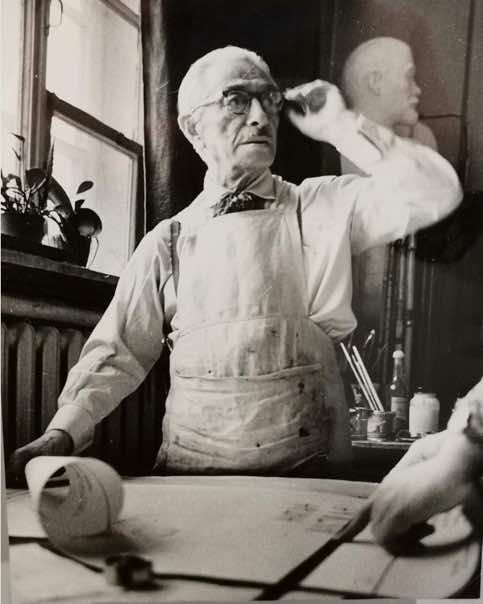 Natan Altman
Natan Altman
(10.12.1889-12.12.1970)
Painter, sculptor, graphic artist, scene-designer.
Natan Isaevich Altman was born to a family of tradesman. In 1902–1907 he studied at Odessa School of Arts under K. Kostandi and G. A. Ladyzhensky, but left it later being dissatisfied with teaching. He returned to Vinnytsia and began to paint independently. In 1910 he moved to Paris, studied in different studios, where he learnt new art schools of that time, including cubism.
In 1906 when he was still a student, Altman exposed his works for the first time. In 1910 he participated in the exhibition of the Society of South Russian Artists in Odessa, in 1911 at the Salon of the National Society of Fine Arts in Paris. He was a member of groups Mir Iskusstva (“World of Art”, 1913, 1915, 1916), the Union of Youth (1913, 1914), 0,10 (1915–1916), Bubnovy Valet (“Jack of Diamonds”, 1916).
Cubistic works of Altman brought fame to the painter. In 1912 he settled in St. Petersburg. He painted the portrait of poetess A. A. Akhmatova (1914, the State Russian Museum), which became afterwards very famous; sculptural Self-portrait (1916); cycle Jewish drawings after the gravestone reliefs (1914). In 1916 he was engaged in theatre design, he designed the play The Miracle of Saint Antony by M. Maeterlinck staged at Literary and Artistic cabaret theatre Comedians’ Halt (“Prival Comediantov”) in Petrograd.
Altman was one of the founders of the Jewish Society for the Encouragement of Artists.
After the October Revolution, Altman as well as a lot of painters of the left movement began tireless public activity. In 1918–1921 he was at the head of easel painting workshop at Petrograd State Free Art Studios (PGSKhUM) — the Higher Art Technical Institute (VKhUTEIN), where he created a number of sculptures. He was engaged in commercial art, designed performance of stage director N. N. Evreinov. The performance was arranged on the occasion of the first anniversary of October Revolution. He also participated in festive decoration of Palace Square (Dvortzovaya Ploschad).
In 1920 Altman created series of expressive portrait drawings of V. I. Lenin, and also bronze sculptures of Lenin in realism style, portrait of A. V. Lunacharsky in plaster cast (the State Tretyakov Gallery). He used elements of suprematism style in the cycle of non-figurative paintings Petrokommuna, Material Selection, Russia. Labour etc.
Later Altman concentrated efforts on graphic arts: easel graphic works (series of portraits of modern writers 1926–1927) and book illustrations (Petersburg stories by N. V. Gogol).
Work at the theatre was very fruitful for Altman. After cooperation with the stage director E. Vakhtangov he acquired reputation of a good scene painter. In 1921 they staged, symbolic for theatre studio Gabima, the play Gadibuk by S. Ansky. At the same time Altman designed one of the first performances of the play Misteria-Buff by V. V. Mayakovsky.
In 1922 Altman cooperated with the Moscow State Jewish Theatre (Goset), designed the performance Uriel Akosta by K. Gutskov, and performance Le Mariage de M. Le Trouhadec by J. Romains.
In the spring of 1928 Altman went on tour of the theatre Goset in Paris, and lived there till 1936. Acquaintance with movements in French modern art inspired him to return to painting. He created landscapes, portraits and still lifes. In his works of Paris period, suprematist and cubist effects disappeared, having given place to impressionist ones. In Paris he created also marvelous illustrations to Petersburg stories by N. V. Gogol, designed several children’s books, created lithographs on the subject of the Old Testament, and was engaged in interior design.
When Altman returned to USSR he had to give up painting, because the manner of his painting did not meet with approval. He had to work mainly in the theatre and book design. Among his outstanding creations of that time were designs for Shakespeare’s famous plays King Lear (1941, the Gorky State Drama Academic Theatre, GBDT), Othello (1944, the Pushkin Drama Theatre in Leningrad), Hamlet (1954, the Pushkin Drama Theatre in Leningrad), costume designs to film Don Quixote (1955), illustrations to works of Sholom Aleichem, V. Blasko Ibanez, E. Castro, E. Zola etc.
Altman was engaged also in decorative art — porcelain painting. During his last years he created some easel paintings after his former scene and costume designs.